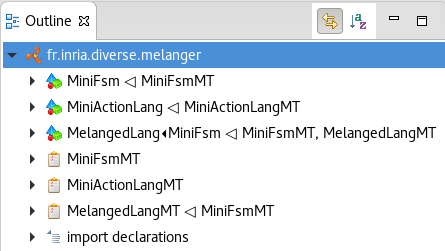In this tutorial you will learn how to load a model with Melange in order to manipulate it conforming to a super language.
You will see also how to perform a downcast.
Setup
We will work on the workspace built in the Assembling multiple DSLs tutorial.
To setup from an empty workspace, import the following projects:
Open the Main.melange file in fr.inria.diverse.melange.fsm/src/fr/inria/diverse/melanger/
We will see how to use the Melange Resource to:
- load a model conform to MelangedLang and use it as a MelangedLangMT model
- load a model conform to MelangedLang and use it as a MiniFsmMT model
- load a model conform to MiniFsm and use it as a MelangedLangMT model
We finish the setup by a right click on Main.melange and select Melange > Generate All
This action will generates a project for each Language and create the classes for the adaptation layer between Languages.
Now that Melange Languages are defined, we have to launch a new Eclipse instance to deploy the plugins present in your workspace.
To do so open the menu Run and selectRun As > Eclipse Application
Basic loading
You will see in this section how to load a model conform to MelangedLang and execute it.
Once you have an Eclipse with the plugins defining the Languages, open the menu File > New > Project... and select Eclipse Modeling Framework > Empty EMF Project, then click Next
Name your project and click Finish.
Create a new file “Sample.minifsm” in the “model” folder and fill it with:
<?xml version="1.0" encoding="UTF-8"?>
<minifsm:FSM xmi:version="2.0" xmlns:xmi="http://www.omg.org/XMI" xmlns:xsi="http://www.w3.org/2001/XMLSchema-instance" xmlns:minifsm="http://melangedlang/minifsm/" initialState="//@states.0">
<states name="Hello"/>
<states xsi:type="minifsm:FinalState" name="World!"/>
<transitions input="//@states.0" output="//@states.1" event="an event"/>
</minifsm:FSM>
We now have a project with a model conform to MelangedLang.
Create a new java class “Main” with a main method.
The first thing to do is to call the Melange setup.
StandaloneSetup.doSetup();
It initialise the Melange runtime by registering EPackages of the Languages and the ModelTypes hierachy.
Then we load the resource “Sample.minifsm”.
ResourceSetImpl resourceSet = new ResourceSetImpl();
MelangeResourceImpl r = (MelangeResourceImpl) resourceSet.getResource(URI.createURI("melange:/file/model/Sample.minifsm?mt=fr.inria.diverse.melanger.MelangedLangMT"),true);
- The URI start with
melange:/to load the model as a MelangeResource. - Next we use the
fileprotocol because we are in a standalone mode. - The URI end with
mt=fr.inria.diverse.melanger.MelangedLangMT. This argument tells we want to load the model as a ModelType.
This loading also add the implementation of the methods defined in the Aspects.
We can now execute the model by calling the method FSM.execute(). The Melange adaptation layer will call the implementation defined in the FsmAspect.
FSM root = (FSM) r.getContents().get(0);
BasicEList events = new BasicEList();
events.add("an event");
root.execute(events);
You should see this result in the console by executing the main.
Start
Exec Hello
End
The full code of the Main class:
package example;
import org.eclipse.emf.common.util.BasicEList;
import org.eclipse.emf.common.util.URI;
import org.eclipse.emf.ecore.resource.impl.ResourceSetImpl;
import fr.inria.diverse.melange.resource.MelangeResourceImpl;
import fr.inria.diverse.melanger.StandaloneSetup;
import fr.inria.diverse.melanger.melangedlangmt.minifsm.FSM;
public class Main {
public static void main(String[] args) {
StandaloneSetup.doSetup();
ResourceSetImpl resourceSet = new ResourceSetImpl();
MelangeResourceImpl r = (MelangeResourceImpl) resourceSet.getResource(URI.createURI("melange:/file/model/Sample.minifsm?mt=fr.inria.diverse.melanger.MelangedLangMT"),true);
FSM root = (FSM) r.getContents().get(0);
BasicEList events = new BasicEList();
events.add("an event");
root.execute(events);
}
}
Upcast
We will then load Sample.minifsm and use it as an instance of the Minifsm Language.
Create a new Java class “MainUpcast.java”
The code of the MainUpcast class is quite similar to the Main class:
package example;
import org.eclipse.emf.common.util.BasicEList;
import org.eclipse.emf.common.util.URI;
import org.eclipse.emf.ecore.resource.impl.ResourceSetImpl;
import fr.inria.diverse.melange.resource.MelangeResourceImpl;
import fr.inria.diverse.melanger.StandaloneSetup;
import fr.inria.diverse.melanger.minifsmmt.minifsm.FSM;
public class MainUpcast {
public static void main(String[] args) {
StandaloneSetup.doSetup();
ResourceSetImpl resourceSet = new ResourceSetImpl();
MelangeResourceImpl r = (MelangeResourceImpl) resourceSet.getResource(URI.createURI("melange:/file/model/Sample.minifsm?mt=fr.inria.diverse.melanger.MiniFsmMT"),true);
FSM root = (FSM) r.getContents().get(0);
BasicEList events = new BasicEList();
events.add("an event");
root.execute(events);
}
}
We changed the mt argument in the URI to see the model as a MiniFsmMT.
melange:/file/model/Sample.minifsm?mt=fr.inria.diverse.melanger.MiniFsmMT
And we changed the FSM class to manipulate the one from the super ModelType.
import fr.inria.diverse.melanger.minifsmmt.minifsm.FSM;
Downcast
Lastly we will load a model conform to MiniFsm and execute it as an instance of MelangedLangMT.
Create a new file “SampleMiniFsm.xmi” in the “model” folder and fill it with:
<?xml version="1.0" encoding="UTF-8"?>
<minifsm:FSM xmi:version="2.0" xmlns:xmi="http://www.omg.org/XMI" xmlns:xsi="http://www.w3.org/2001/XMLSchema-instance" xmlns:minifsm="http://minifsm/minifsm/" initialState="//@states.0">
<states name="Hello"/>
<states xsi:type="minifsm:FinalState" name="World!"/>
<transitions input="//@states.0" output="//@states.1" event="an event"/>
</minifsm:FSM>
Create a new Java class “MainDowncast.java”
The code of the MainDowncast class also look like the Main class:
package example;
import org.eclipse.emf.common.util.BasicEList;
import org.eclipse.emf.common.util.URI;
import org.eclipse.emf.ecore.resource.impl.ResourceSetImpl;
import fr.inria.diverse.melange.resource.MelangeResourceImpl;
import fr.inria.diverse.melanger.StandaloneSetup;
import fr.inria.diverse.melanger.melangedlangmt.minifsm.FSM;
public class MainDowncast {
public static void main(String[] args) {
StandaloneSetup.doSetup();
ResourceSetImpl resourceSet = new ResourceSetImpl();
MelangeResourceImpl r = (MelangeResourceImpl) resourceSet.getResource(URI.createURI("melange:/file/model/SampleMiniFsm.xmi?lang=fr.inria.diverse.melanger.MelangedLang&mt=fr.inria.diverse.melanger.MelangedLangMT"),true);
FSM root = (FSM) r.getContents().get(0);
BasicEList events = new BasicEList();
events.add("an event");
root.execute(events);
}
}
The URI is what it has changed:
- The loaded model is a MiniFsm one’s
/file/model/SampleMiniFsm.xmi - MelangedLang is not a super Language of MiniFSM so we can’t directly cast the model to MelangedLangMT.
But Melange offer the possibility thanks to the argumentlangto create a copy of the original model but as an instance of the specified sub-Language.lang=fr.inria.diverse.melanger.MelangedLang - Thanks to the
langargument we can manipulate the model as a MelangedLangMTmt=fr.inria.diverse.melanger.MelangedLangMT
